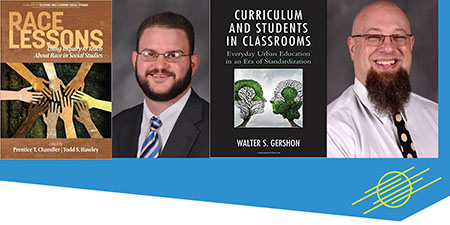Two professors in ΜμΜμ³ΤΉΟβs School of Teaching, Learning and Curriculum Studies say race plays a factor in the lives of every student.
βEducation is always deeply related to sociocultural norms and values,β says Walter Gershon, Ph.D., associate professor in the School of Teaching, Learning and Curriculum Studies. βThe systems are biased, and education is influenced by race, class and gender.β
βAll you have to do is watch the news to see that race is constantly a topic, even though people like to act as if racism has disappeared and are shocked when events like what happened in Charlottesville occur,β says Todd Hawley, Ph.D., associate professor of social studies teacher education in the School of Teaching, Learning and Curriculum Studies. βAll you have to do is pay attention to see race is a part of the NFL, police relationships with the community and the current presidency.β

These statements are the premises on which two new books were recently published.
Dr. Gershon and Dr. Hawley both produced and published books this past year focusing on the ideas of race lessons in school curricula and educational environments.
Dr. Hawley began work on editing his book a year and half ago with his co-editor Prentice T. Chandler.
βWe produced it because we believe you canβt teach social studies without exploring issues of race and racism,β Dr. Hawley says. βWe wanted to find a way to help support teachers, specifically social studies teachers, to use inquiry to teach about race in their classrooms.β
This book was a follow-up to Chandlerβs book that was published in 2015 focusing on critical race theory and specific ideas on how to go about teaching race in social studies classrooms. The goal of their new book is to help address the need for materials on race in social studies classrooms and to make teaching about race more accessible for teachers.
This book is especially relevant now, Dr. Hawley says, because of the current educational climate. He says if social studies teachers are not teaching students to address racism, then they are not addressing the problem.
βTeachers can overcome this by seeing themselves as part of helping create citizens who want a world that confronts racism and make lives better for citizens of color. I believe reading the book can help with this,β Dr. Hawley says.
βSome teachers wonβt teach about race because they are afraid of pushback from parents, are unsure how to have deep conversations in their classrooms, and they do not want to come off as biased or teaching with an agenda,β Dr. Hawley says.
Dr. Hawley adds that teachers can overcome this by viewing their students as intellectually capable enough and more than able to talk about race. He also believes teachers need to have confidence and know that they are smart enough to provide resources and readings that promote discussion of ways to confront racism. Dr. Hawley pointed out that school systems and communities need to support teachers who are doing this work.
Dr. Hawley recommends this book to classroom teachers and undergraduate education students.
Dr. Gershonβs book was created due to the lack of books out there that talked about classrooms on a daily basis.
Dr. Gershon shared how formal curriculum, which is knowledge we intend to give students such as tests, worksheets and books, is presented regardless of actual classroom environment. The book focuses on three kinds of curriculum, which are formal, hidden (often-implicit norms and values) and enacted.
βWhat was happening in classrooms and what teachers do and how curriculum influences students on a daily basis are what I focused this book on,β Dr. Gershon says.
Although this book is written for an academic audience, Dr. Gershon focused on writing in an accessible and understandable way.
βPeople reading this book want to be able to think about what they know from a slightly different perspective,β Dr. Gershon says. βThey also should be interested in seeing what everyday education looks like in urban and suburban schools.β
This book goes into detail on the specifics of how diversity affects the type of education people receive.
Dr. Gershon says that one thing readers can take away from this book is that what appears to be common in an everyday classroom environment is actually made up to be what we are accustomed and used to.
He shared an example of this by describing an activity he does with his classes where he asks them to name five female scientists, and typically his classes can come up with two names. When his class is asked to name five male scientists, they are able to do so without hesitation.
βThis is how the bias is shown and how it works in classroom environments,β he says.
Learn more about ΜμΜμ³ΤΉΟ Stateβs School of Teaching, Learning and Curriculum Studies
